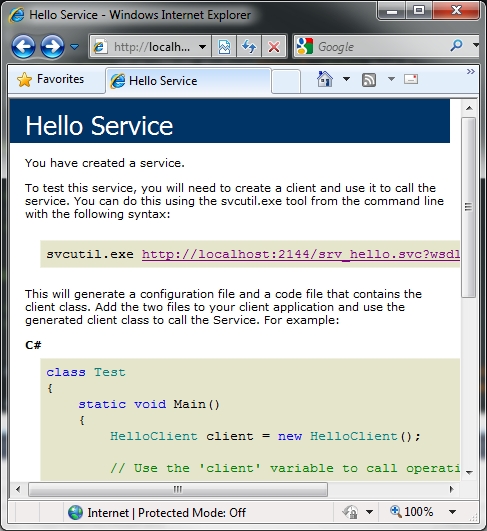For hosting WCF Services in IIS you usually need a .svc file. This File exposes your Service.
With ASP.NET virtual Paths you have the opportunity to load your service without a .svc file.
You can put the WCF Service inside a DLL without adding a reference to the ASP.NET WebApp.
Implementation:
– Create a Class derived from VirtualPathProvider and override the Methods GetFile and FileExists. |
– Create a Class derived from VirtualFile and override the Method Open. |
– Create a Class derived from ServiceHostFactory and override the Method CreateServiceHost. |
– The VirtualPathProvider manages the calling URLs and returns a VirtualFile, if the client calls a WCF Service. |
– The VirtualFile generates the .svc Content. |
– The ServiceHostFactory hosts the WCF Service. |
– Register the VirtualPathProvider in global.asax |
Here is the code: (VirtualPathProvider)
public class ServicePathProvider : VirtualPathProvider
{
public override VirtualFile GetFile(string virtualPath)
{
if (!this.IsServiceCall(virtualPath))
return this.Previous.GetFile(virtualPath);
return new ServiceFile(virtualPath);
}
private bool IsServiceCall(string virtualPath)
{
// Check if it is a wcf service call
virtualPath = VirtualPathUtility.ToAppRelative(virtualPath);
return (virtualPath.ToLower().StartsWith("~/srv_"));
}
public override bool FileExists(string virtualPath)
{
if (!this.IsServiceCall(virtualPath))
return this.Previous.FileExists(virtualPath);
return true;
}
}
VirtualFile
public class ServiceFile : VirtualFile
{
public ServiceFile(string virtualPath)
: base(virtualPath)
{ }
public string GetCallingServiceName
{
get
{
// Return class name. srv_hello.svc => hello
return base.VirtualPath.Replace("/srv_", string.Empty)
.Replace(".svc", string.Empty).ToLower();
}
}
public string GetService()
{
string srv = this.GetCallingServiceName;
// hello => Hello
return srv[0].ToString().ToUpper() + srv.Substring(1);
}
public override Stream Open()
{
var serviceDef = new MemoryStream();
var defWriter = new StreamWriter(serviceDef);
// Write host definition
defWriter.Write("<%@ ServiceHost Language=\"C#\" Debug=\"true\" Service=\"Services."+ this.GetService() + "\" " +
"Factory=\"DynamicServices.DynamicHostFactory, DynamicServices\" %>");
defWriter.Flush();
serviceDef.Position = 0;
return serviceDef;
}
}
ServiceHostFactory
public class DynamicHostFactory : ServiceHostFactory
{
public DynamicHostFactory() { }
public override ServiceHostBase CreateServiceHost(string constructorString, Uri[] baseAddresses)
{
// Load bin/services.dll
var asm = Assembly.Load("Services");
var serviceType = asm.GetType(constructorString);
var host = new ServiceHost(serviceType, baseAddresses);
// Add endpoints. (In this example only IHello interface)
foreach (Type contract in serviceType.GetInterfaces())
{
var attribute = (ServiceContractAttribute)
Attribute.GetCustomAttribute(contract, typeof(ServiceContractAttribute));
if (attribute != null)
host.AddServiceEndpoint(contract, new BasicHttpBinding(), "");
}
// Add metdata behavior for generating wsdl
var metadata = new ServiceMetadataBehavior();
metadata.HttpGetEnabled = true;
host.Description.Behaviors.Add(metadata);
return host;
}
}
Global.asax
void Application_Start(object sender, EventArgs e)
{
HostingEnvironment.RegisterVirtualPathProvider(new ServicePathProvider());
}
Example:
I created a DLL (Services.dll) with a WCF service. Here the Code:
[ServiceContract]
public interface IHello
{
[OperationContract]
string SayHello(string name);
}
public class Hello : IHello
{
public string SayHello(string name)
{
return "Hello " + name;
}
}
I compiled the DLL and copied it into the bin Folder of the ASP.NET Application.
When I start the WebApp and call the URL “http://localhost:{Port}/srv_hello.svc” the Service UI of the Hello Service (Services.dll) will be generated. Voila! 😉

EDIT:
Since WCF 4.0 there is another way to achieve the same thing. It is called “file less activation”. 🙂
Example: